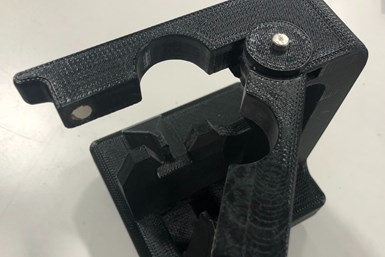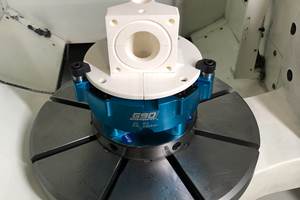Is 3D Printing in Your Shop or on Your Radar?
Recent shop visits reveal that some machining businesses have added/are considering adding 3D printing equipment, while others are content sending that work — for items such as polymer fixtures and jigs — to outside vendors.

According to Ultra Machining Co., 3D printing this CMM fixture in plastic took only 24 hours, but it likely would have taken upward of a week to produce using conventional toolroom metal machining methods.
2021 has been enjoyable in that I’m back to visiting machine shops in person. In fact, in September, I squeezed in visits to four shops that I will profile in upcoming issues of our magazine.
All shop visits are unique as are the stories I create about them. But, for a number of years, one common question I’ve asked during each visit, no matter the topic I traveled there to learn most about, is if 3D printing is being used there or if the shop is considering adding that equipment.
Most recently, the answer has been that, while 3D printing is on the shop’s radar, it’s easier to hire an outside company to print items such as polymer jigs, fixtures, robot end effectors and other components for use on the shop floor. And many of these shops have had their own questions (and concerns) about metal 3D printing relative to the price of the equipment, range of material types, printed material density and strength, and so on.
But that hasn’t always been my experience. I recall a road trip a few years ago when I spent four days visiting seven CNC machine shops in and around Minneapolis, Minnesota. Something I found interesting is six of them were using 3D-printing equipment to create polymer components in some way. A couple had metal 3D printers, too.
One of those six shops was Monticello’s Ultra Machining Company (UMC), which primarily serves the aerospace and medical markets. UMC purchased its first 3D printer in 2014, a Stratasys Fortus, that prints parts in acrylonitrile butadiene styrene (ABS) polymer.
I learned that UMC uses polymer 3D printing for various reasons. During the quoting and design for manufacturability stages, it commonly 3D prints prototypes for the new job. This is, perhaps, the most common use of plastic 3D printers among machine shops. UMC feels this gives the shop a better idea of how to best fixture the part on a machine, helps identify areas where cutting tool or spindle clearance might be an issue, helps determine the best way for a tool to approach a certain feature to be machined and so on. Although some of this can be gleaned by examining a part’s 3D CAD model, UMC often finds it more beneficial to have something physical to hold and manipulate by hand. For large aerospace parts, UMC might 3D print them at a smaller scale.
The shop also 3D prints fixtures that secure parts to be measured on its coordinate measuring machine (CMM). One example I saw was a two-piece fixture featuring a base and hinged door. Once the part is installed in the fixture base, the door is closed around it and magnets keep it shut. Because it is made from polymer and not metal, it will not mar a part’s finish. This is important because those parts are machined for a medical application in which appearance is just as important as functionality.
Do you have 3D printing capability? If so, how are you benefiting from it?
Plus, turnaround time to 3D print the fixture is faster than machining and assembling one from metal. The shop can 3D print both components of this fixture at the same time in 24 hours. Conversely, it would take upward of a week to make this out of metal when one considers the time it would take to obtain material, machine what would be five components, then assemble them. The only assembly required for the polymer fixture is adding a pin to connect the door to the base. The print job is paused at a certain point to add the magnets, then printing continues, securing the magnets in the polymer.
When I visited, UMC said this printer runs nearly 24/7. That certainly was not the case at first as many employees pretty much ignored it. However, the shop had launched an engineering internship program about the time it purchased the printer. Although those college juniors and seniors were “green” when it came to conventional machining and manufacturing approaches, the shop says they really took to the 3D printer and were designing and printing parts within a matter of days.
In fact, the students solved a problem the shop was having protecting certain areas of a part during grit blasting. Their idea was to 3D print molds to create rubber masks to protect the areas of the part that did not call for an abrasive surface finish.
Ultimately, UMC’s seasoned employees saw how those “inexperienced” young people were using the 3D printer and that spurred them to learn how to use and benefit from it, too. The shop found that to be key. That is, ingraining 3D printing into its company’s culture.
Related Content
Gift a 3D Printer to an Employee?
Some shops have purchased inexpensive polymer 3D printers for their operations. Does it make sense to take this a step further and give (or loan) a sharp young employee one to experiment with at home? This small investment could pay off for your shop in different ways.
Read MoreUpgrading Bar Feeder Components with Metal 3D Printing
Index is exploring redesigning and optimizing parts for bar feeders inside its multi-spindle turning centers using a low-cost metal 3D printing platform from One Click Metal.
Read More5 Big Themes in Additive Manufacturing at Formnext Forum: Austin
As manufacturing advances with additive, the advance increasingly emphasizes these five themes.
Read MoreCan Machining Metal 3D-Printed Parts be a New Business Opportunity?
Perhaps. And shops could use their existing CNC machines to remove 3D part-print supports, to trim parts and so on. But dedicated robotic machining systems could be an alternative.
Read MoreRead Next
3D Printing Creates a Window of Automation Opportunity
For this Omaha shop, periodic part inspection required an automated turning cell to pause production. Printing a plastic parts collection chute for delivery outside the cell solved this problem, and it turns out the shop has found 3D printing to be valuable in many other ways.
Read MoreNon-Machining Processes Worth Considering
Here are three in-house processes outside of machining parts from which your shop, employees and customers could benefit.
Read More3D Printing’s Value in a Production Turning Environment
A shop had a problem with chips and coolant being shot back through tube material it was machining on a bar-fed CNC turning center. Its solution was to 3D-print a plug to insert into the back end of the tubes. It uses its 3D printer in other ways, too.
Read More













.jpg;maxWidth=300;quality=90)








